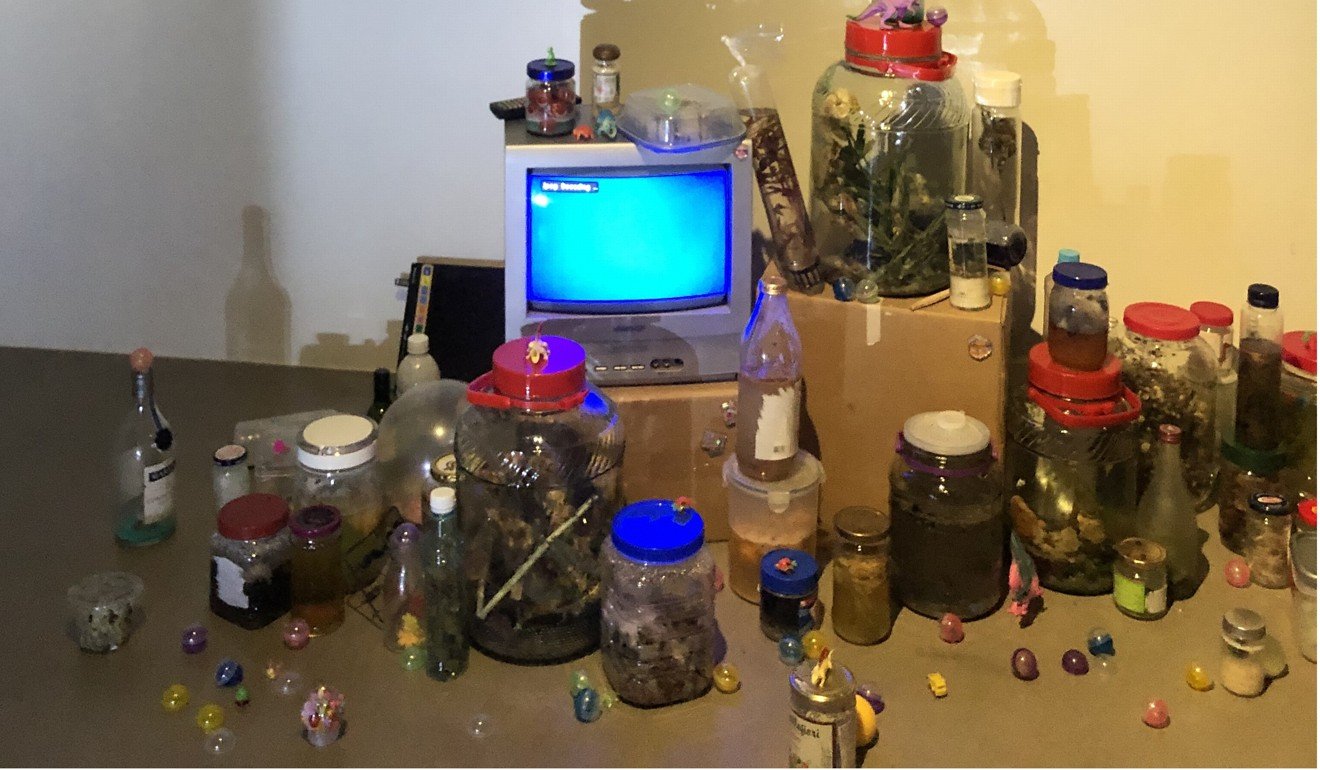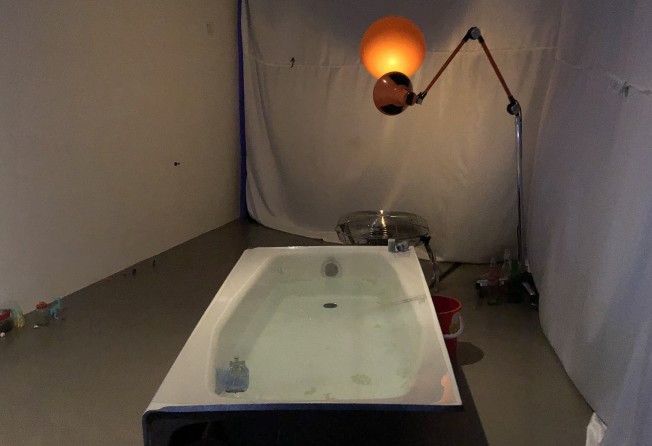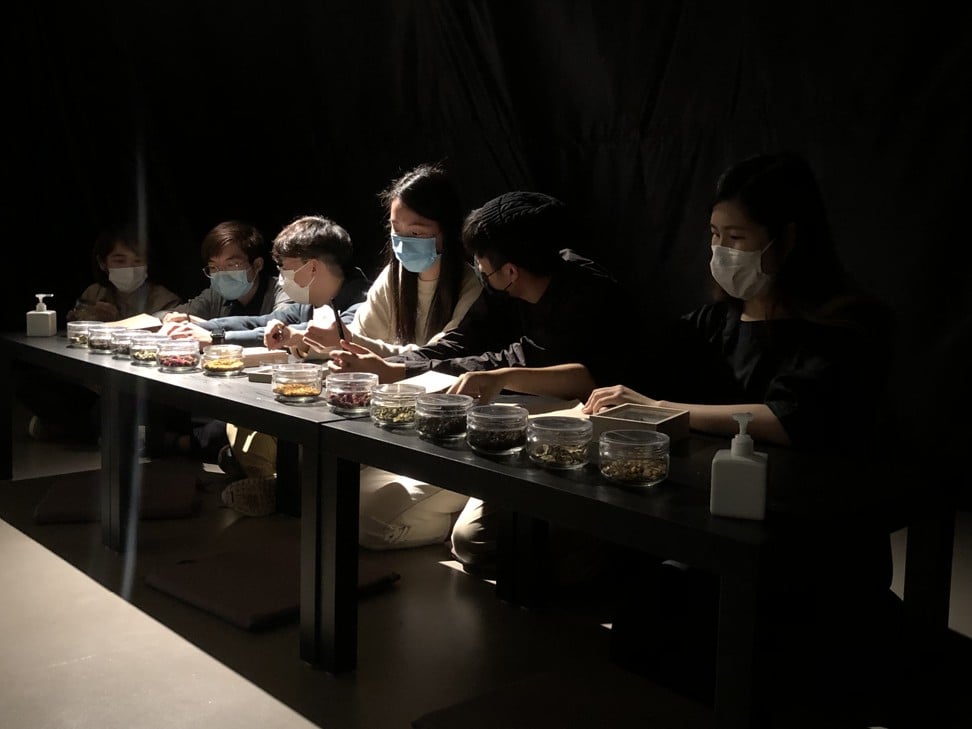
Five stages of trauma recovery brought to life by artists amid Coronavirus outbreak and Hong Kong protests help audience deal with current times
- The coronavirus outbreak and Hong Kong protests prove the perfect foil for a new exhibition at OUR Gallery in Wan Chai, ‘The Healing Cave’
- From ‘Outcry’ to ‘Completion’, the five installations were created by 12 Chinese University student artists

When a group of 12 Chinese University student artists put together the exhibition “The Healing Cave”, they could not have imagined the relevance it would have to the present situation in Hong Kong.
The exhibition, which runs until the end of March at OUR Gallery in Wan Chai, is an artistic response to the five stages of trauma recovery, with one installation representing each stage.
It’s an adaptation of an earlier on-campus exhibition that took place in late September during Hong Kong’s anti-government protests, but before the university hit the headlines internationally after it became a battleground between police and protesters.
The onset of the recent coronavirus make the pieces even more tailored to current times, as we collectively deal with the outbreak, having lived through the Sars epidemic 17 years ago.

The first stage, “Outcry”, is a large wash basin that sits in a darkened room; it’s filled with water and engraved in the sink is a graphic that shows a towel being wrung, with the inscription “Let it All Out” (it was initially conceived as a participatory installation, but for hygiene reasons was replaced by a static, resin sculpture).
Stage two, “Numbness and Denial”, is a room filled with odd juxtapositions – mould trapped in jars, alongside dinosaur figurines, a water-filled bathtub that contains a toy boat in motion, and a fan that keeps an orange balloon afloat before a spotlight.
“There are many moving parts in this installation, but they mainly run in a loop – even the items inside jars, the bacteria, is multiplying invisibly,” says its co-creator Isaac Wong Hong-tik.
“This parallels the effects of this numbing and denial stage, when all parts are moving, but on autopilot, where there are no emotions, there is a sense of disassociation. It’s a defence mechanism, but it’s also not a healthy one – something is festering while you rest in what seems like a comfort zone.”
Natalie Chu Lok-ting, who also worked on the piece, adds: “When we first staged this exhibition, we did ask the question: do we need to make this art as therapy? But what we wanted to do is reproduce these stages and feelings. To allow viewers to take a step back and have a bystander’s perspective on how others deal with trauma, and through that, find resonance.”

Stage three is called “In the Intrusive Re-experiencing” and is a video work that replays a number of image fragments. “Incidents may have quieted down, the world may seem to have moved on, but these images, these repressed memories, will continue to return to your consciousness, in sudden moments, causing anxiety,” says artist Ciel Yeung Yik-ning.
Many of the moving images reference water, a consistent thread of the exhibition. In the fourth stage, “Working Through”, water is mentioned with the words “like water” written in calligraphy before a station where visitors can make their own tea bags from seven types of tea leaves that represent the seven basic emotions. At these stations viewers are also invited to share personal traumas on paper (letters are then placed in a ready-made postbox anonymously), and to read the traumas of other exhibition-goers.
The fifth and final stage, “Completion”, represents healing and is shown in the corridor outside the gallery. Cloudlike forms line the walls and ceilings consisting of packets of seeds that visitors can take away.
“If you can take what you’ve learned, you can plant it and let it grow into something new,” says Kuby Cheung Tsz-man, who not only took part in creating the fourth artwork with Larry Chan Lun-tak, but curated the entire exhibition. “Trauma is so commonplace now, and it’s second nature to associate it with negativity. We can’t compare traumas.
“A seed, in this instance, is a validation of even the smallest of traumas, and is an acknowledgement that trauma can and will grow – which can be positive or negative, depending on how we each deal with it.”
There were times we questioned what we were doing. While people on the street were fighting for supplies [due to the coronavirus], why were we sitting here making art? But we need a place to let our minds roam elsewhere
The curatorial process was particularly important in this exhibition, to create a “healing cave” that is cohesive, collaborative and – dare we say it – hopeful.
Grouping solo artists in pairs or trios to create each work was in itself a radical proposition, but one Cheung thought was essential to better express the healing process.
“Trauma is usually experienced alone, just as art is often created alone. But this exhibition required cooperation both in conceptualisation and execution,” she says.
“I have personally dealt with PTSD as a result of verbal abuse. I didn’t know or understand these five stages at the time, but I went through them. What got me through was maybe something as simple as human understanding. Words are what hurt me but they are also what can heal me.”
The participatory element is strong across the exhibition, underlining the necessity of taking action, and sharing – for example, in the first letter Cheung pulls out of the fourth installation’s postbox, a contributor shares that she is dealing with a vaginal infection.
“It is a reminder that a lot of traumas are not collective – they are personal and invisible, but important. We created this exhibition during a highly traumatic period in our city’s history. Art cannot change the times, but we can hopefully give people a release,” says Cheung.
“There were times we questioned what we were doing. While people on the street were fighting for supplies [due to the coronavirus], why were we sitting here making art? But we need a place to let our minds roam elsewhere. Instead of doing a mental inventory of supplies we have, we need to find a place that we collectively find peace.
“You could say the tone of the exhibition is optimistic, but that’s not exactly it. It’s more that we want to show that PTSD is normal and every day. Emotional illnesses should not be perceived by society as negative.”